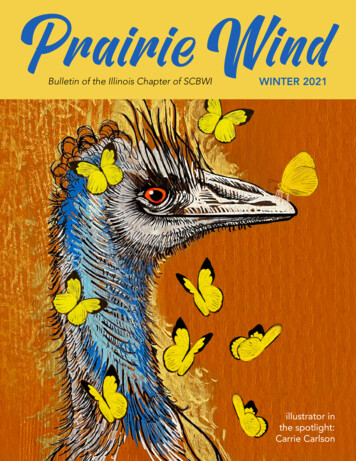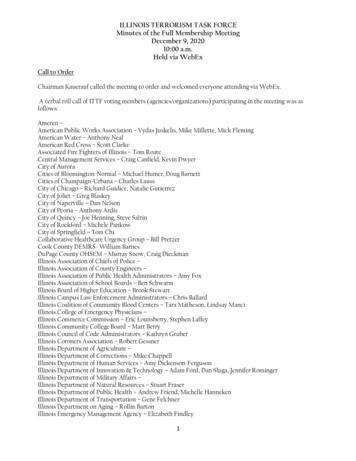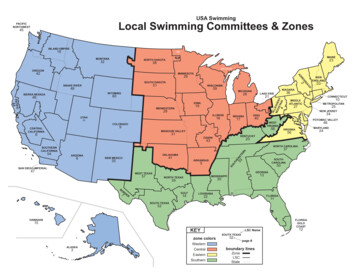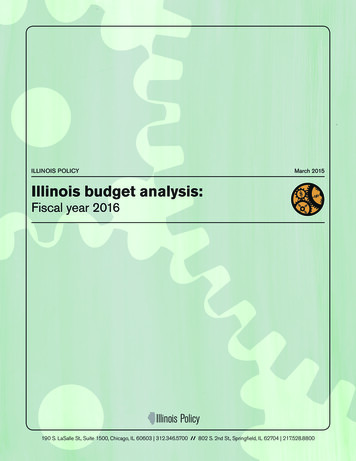
Transcription
Bulletin of the Illinois Chapter of SCBWICONTENTS 1WINTER 2021illustrator inthe spotlight:Carrie Carlson
ContentsOPENINGSPOTLIGHTSIn This Issue.3Greeting.5Illustrator in the Spotlight.9Tales from the Front.11Creative Sparks.13FEATURESCOLUMNSHow to Write a (STEAM) Superhero Storyby Karla Valenti.15The Songs in Our Storiesby Alina Celeste Hevia.18A Fly on the Wall.21Voices of Change.24Shop Around the Corner.26Inside Story.29Illustrator’s Tips.32Writer’s Tips.35Writer’s Bookshelf.39Mentor Texts.41NEWSNews Roundup.43Illustration byCarrie CarlsonCONTENTS 2
In This Issueby Amy AlznauerTo kick off this new year, we have a slightly slimmer butstill mighty Prairie Wind for you. Carrie Carlson’s coverillustration alone—stunning in its simultaneous beauty,humor, and whimsy—will lift your spirits. And there’s somuch more inside. Here are some short takes on the wisdom,inspiration, and tips from our columnists to entice you:In her Greeting, Debbie Topolski starts us off with acharacteristically warm and exuberant summary of the manyways our chapter has risen (heroically, I might add) to thevirtual requirements of this time.FEATURESKarla Valenti’s piece, How to Write a (STEAM)Superhero Story, charts the origins of her new illustratedseries on superhero scientists who battle against variousoppositions (which in the book take the form of cleverand adorable little devils). And she simultaneouslychallenges all of us “to show up and continue facing ourAntagonist” until we come out triumphant.Alina Celeste Hevia’s The Songs in Our Stories tells aremarkable history of the interplay between lullabiesand picture books that will leave you with a deeperappreciation of both: how they both gain their power inrhythm and repetition and how both speak to child andadult, soothing and yet also acknowledging the darkerside of parenthood. Read this piece also for Hevia’s insightinto how picture book structure takes its form from ouroldest human stories and her wonderful tips for singing apicture book aloud.COLUMNSIllustration byCarrie CarlsonIN THE SPOTLIGHTThe art, nature journal excerpts, and career story of this issue’sIllustrator in the Spotlight Carrie Carlson will be sure todelight and inspire your own artistic endeavors. And similarly,in Keir Graff ’s beautiful Tale from the Front we get an insidelook at an author’s creative process (“working backward” fromtitle to book, thinking up wildly inventive promotion ideas).We put together our Creative Sparks section a littledifferently this time. We first chose the simple yet probingand lyrical moon poems by Sallie Wolf. Then we passed thesealong to illustrator Andrea Hill Fitzgerald, asking her toselect images she thought might sit nicely on the page besideeach poem. The pathos and beauty of Fitzgerald’s paintingsboth light up the page and the poems.BACK TOCONTENTS PAGEOPENING In Voices of Change Lisa Sukenic offers a compellingevolution of LGBTQIA literature, which makes alovely companion piece to Nathan Lyon’s annotated listin our previous issue. And Carol Coven Grannick’s InsideStory focuses this time on flexibility and strengtheningresilience, taking metaphoric cues from winter prairiegrass that “is cold and frozen, but still bends with thewind, rooted deeply in the earth.”Josh Cohen interviews Suzy Takacs, owner of The BookCellar, who tells stories of a dream realized, a womanowned business, a community formed, and a lock-downweathered. And in Mentor Texts, continuing the focuson bilingual books (begun on page 18 by Hevia), JennyMorales provides an irresistible list of Spanish/Englishtitles.In Illustrator Tips Matthew Atkins takes us into thefascinating world of user experience design (or UX, asit’s known in the industry) and in doing so illustratesthe power of story (and storyboarding!) to transform3
In This Issueour lives and work. And Patricia Hruby Powell’s Writer’sTips moves from the premise that “the underlying objectof reading is to have an emotional experience” to how wemight bring that about on the page through characterdevelopment.Director Amy Alznauerwho joyfully plans and acquires content for each issueEditor Pamela DellLast but not least, Natalie Rompella takes a new approachto Writer’s Bookshelf, diving not into books on craft butblog posts on craft. Here you will find, as she puts it, littlegems, enticing and truly helpful posts on everything froma brass-tacks analysis of voice (literally tools for countingtypes of words and phrases) to tips on tightening sentencesto wonderful pieces on how writing affects the brain.who expertly tweaks and polishes all of our contentDesigner Brooke O’Neillwho creatively designs and lays out every pageAdvisor Jenny Waghwho remains our faithful and supportiveRegional AdvisorA big thank you to Kelly Darke for rounding up all of ourSCBWI news, and as always, I’m grateful to our PrairieWind team of hard-working, inspiring, and supportivewomen.Illustration byCarrie CarlsonBACK TOCONTENTS PAGEOPENING 4
GreetingDecker Dog, patronsaint of those whowait.by Deborah Topolski, Co-RA SCBWI-ILREACHOver these many months, dog was my co-pilot. What bettercompanion is there in a world of waiting? Dogs are championwaiters because when one lives in the now, time flies. Myspouse maintains that a dog’s life is short because canines liveevery moment fully, so theirs is a sped-up time line. Becausethey experience time more quickly, dogs are one step ahead.They catch the ball every time and are first to reach thatmorsel. When reunited with a dog, you pick up right whereyou left off, as if you parted only a moment before. When youexist for simple joys, every day has promise; every encounteris new; every moment is fleeting; and every reunion is worththe wait.When I was growing up, my mom said the only thing I hadpatience for was my art. Simple joys and everyday comfortselude the impatient. For a person without patience, living inthe moment is a bit of a reach. So, over the past months, withmy dog as my role model and coffee as my comfort, I learnedto reach.A BIT OF A REACHSo, what is a Co-Regional Advisor whenshe’s (literally) at home? With events beingcancelled, a volunteer event-planner is notin much demand. How can anyone steward aregion that thrives on meet-ups and supportsitself with in-person retreats and conferencesfor hundreds?A pre-pandemic cafecitoand a Cubano atBodega, St. PetersburgI was picking up my spouse from what wouldbe his last regular commute when I got a callfrom Sarah Aronson, our PAL & PublishedCoordinator. Sarah suggested she would like to use Zoomto host a Monday Night Chat—or hour-long hangout—for members to check in and be in the moment. We wouldplan what we would come to call “the show” with Sarah’strademark 3Cs—craft, creativity, and community.What we thought would last a half-dozen weeks stretchedinto October! Highlights included a LGBTQ book talkwith Nathan Lyon, a celebration of Equity & InclusionPrize-winners Erica Thomas and Alina Celeste Hevia, andBACK TOCONTENTS PAGEa sneak peek into the Illustration Mentorship with RobinHann and mentor Terri Murphy. Everyone who attendedanother session, with Wendy McClure, an editor at AlbertWhitman & Co., was invited to submit to her there. Asa result, Carolyn Crimi’s work-in-progress was taken toacquisition!There were many more great Monday chats as well. AllanWoodrow gave us tools to make a living as writers. Wecelebrated Indigenous Peoples’ Day with Carole Lindstrom,dared to be our true selves with Chicago YA author GloriaChao, and celebrated the power of poetry with NikkiGrimes. Michele Weber Hurwitz hosted a fun trivia nightto help us all learn more about each other and our work!With each attendance, participants were entered intoa monthly drawing. Winners received a signed book,membership renewal, or a free webinar package—justto keep things fun. Monday Night Chats also helpedour community and planners with their Zoom meetingskills. What at first seemed a bit of a reach—maintainingcommunity in the midst of a pandemic—turned intosomething I looked forward to every Monday night thanksto Sarah Aronson and all our weekly contributors.OUT OF REACHFor many, the book launch is acelebration years in the making. Debutcreators, along with family, longsuffering critique group partners, andfriends, especially look forward to theirfirst book talk. When social distancingforced independent booksellers toclose their doors to literary gatherings,the elusive book launch was suddenly Finest china to toast ourout of reach.fairy-godmother RAEs!During our first regional team brainstorming sessionto decide how to confront the constraints imposed byCOVID-19, Esther Hershenhorn and Alice McGinty, ourCo-Regional Advisors Emerita, came up with a plan. Topromote members’ 2020 books, SCBWI-IL would host, onOPENING 5
GreetingREACH OUTDespitefindingthesework-arounds to maintaincommunity and celebrateour accomplishments, itlooked like, if we wanted tocreate real opportunity forour members, we’d have torebrand our much-lovedregional events. Beingbetter together was going tohave to happen online.Campfire in a boxA comforting cup reminds us that new ideas bloom from adversity.its new YouTube channel, a weekly virtual book launch foreach participating member. Combined with promotion onsocial media, a book giveaway with #ReadLocalILLINOIS/iCARE grant funds, and links to order from PAL members’favorite independent bookstores, each author got thespotlight their books deserved during the pandemic.Our new SCBWI-IL YouTube channel would become alifeline, hosting Virtual Book Launch Parties well intoNovember. In April, teachers, librarians, SCBWI members,and enthusiasts celebrated with debut authors KarlaArenas Valenti, Amy Alznauer, and Kim Oclon. May wasmade exquisite with the collaborations of author SuzanneSlade and illustrator Cozbi Cabrera as well as author AliceMcGinty and illustrator Alan Havis. My own Decker Dogparticularly enjoyed Lone Wolf (HarperCollins) by debutauthor-illustrator Sarah Kurpiel. By June, art reflected life.Lisa Katzenberger taught us how to celebrate every day andPatricia Hruby Powell’s timely biography Lift as You Climb:The Story of Ella Baker (McElderry/Simon & Schuster)reflected social struggle in the streets. Karla Clark’s You BeMommy (Macmillan) became an anthem for quarantinedparents everywhere and Kate Hannigan’s graphic novel TheGreat Chicago Fire: Rising from the Ashes (First Second/Macmillan) spoke of the resilience for which Chicagoansare known. Fall brought still more parties with Ruth Spiro,Kier Graff, Malayna Evans, Joy Michael Ellison, Carol CovenGrannick, Jennifer Grant, and Denise Tracey McGowan.BACK TOCONTENTS PAGEAfter cancelling a sold-out Spring Thaw: Pitch Perfect 3,Co-Regional Advisor Jen Wagh and I collaborated withAssistant Regional Advisor Deb Aronson and longtimeWords in the Woods team member John Bowen toreimagine our biennial summer retreat. Our solution,Words on the Web—with its Wired Walk and ConnectedCampfire—was a WOW of an event, spanning three daysand five U.S. time zones!In the fall, by using Illinois Interactive’s Cosmic Concierge, wenavigated our way to a virtually perfect conference.WOW taught us a lot about creating meaningfulconnections through Zoom and about what translatedeffectively from an in-person event. Our ConnectedCritique Groups had the benefit of meeting several timesvia Zoom before the weekend conference even began.Many of these groups stayed together afterward, reviewingand supporting each other well after the event concluded.Plus, Jenny Wagh’s “S’more attendee care packages” closedthe distance as we reached out to support one another andour work.OPENING 6
GreetingREACH FOR THESTARSJust as with the first cosmicexplorers, it took a leap of faith forRich Green, Lisa Bierman, RachelRuiz, Sarah Hammond, DarcyZoells, and the regional team to gobig in planning our rebranded fallconference—Illinois Interactive.Although it had been a year inthe making, the team struggledin the initial days of lockdown toIllinois Interactive team carereimagine the in-person event as apackage from chair Jen Wagh.virtual trip into outer space, whereattendees could reach for the stars.But we got there! With an opening keynote by astronautand children’s author John B. Herrington, the first NativeAmerican in space, planners focused not on what we couldn’tdo in person—but what we achieve only virtually!members and not-yet-members. Plus, with distance barriersswept away, more can attend. Among the many value-addedprograms we offered were a morning with Rahele JomepurBell, courtesy of Louann Brown and Jerry Barrett of theDownstate Illustrator’s Network; Liesl Shurtliff ’s timemanagement presentation through the North SuburbanNetwork, and the Springfield Area’s Debra Daughertyhosting rhyme-master Lori Degman.The result was an outta-this-world online experience, withmany aspects that could never be offered in-person. Avirtual Portfolio Showcase allowed industry professionalseverywhere to view illustrators’ work. Our online conferencebookstore gave all published attendees an opportunity topromote and sell their books. Small group sessions fostereda truly interactive experience, with professional feedback andQ&A with industry professionals in every live session. Andthe SCBWI-IL Crystal Kite Gala promoted 2020 PAL booksthroughout the galaxy! Plus, our PAL faculty created fiveamazing craft breakouts—more than we could ever attendin-person.It was such an honor to work with our faculty and team ofvolunteers on this watershed event! And much of what welearned together in planning and innovating will be reflectedin programs for years to come.WITHIN REACHWith a Covid vaccine close at hand, we look forward tocoming together again in person. Until then, Illinois networkrepresentatives are doing more than ever to create connectionand to continue reaching out to our wider kidlit communities.This year, writing, illustrating, and diversity networks havemigrated to Zoom and are still free to Illinois residents—bothBACK TOCONTENTS PAGEMy mom always used to invite neighbors over for coffeeand something sweet. When in-person network eventsreturn, we hope to offer a little something extra too bybuilding upon a hybrid model of in-person/streamed events.Creating this flexibility will make more programs accessibleto members who are immune-compromised, caring forfamilies, or working evenings or weekends when most inperson events are traditionally scheduled. Gratefully, ournetwork representatives have kept us connected whilekeeping knowledge within reach.OPENING 7
GreetingREACH FOR THE BEST INYOURSELFSo much of our experienceduring these past monthshas been a balance oftaking the good withthe bad, cancelling outuncertainty and a lackof confidence by simplyreaching out for help.Rich Green said to me, “We’ll A cup shared at the 2020learn more in adversity than NY Conference.we ever will in good times.” Allof our Illinois volunteers and kidlit literary partnersreally reached beyond their comfort zones these pastfew months to help our region thrive. They tried thingsthey’d never tried, found new ways to connect and serve,and put themselves out there while sheltering in place.Despite the uncertainty, we’ve reached for the best inourselves. We’ve learned not only what we can do butwhat we can do without—what’s unnecessary to ourprocess. Going forward, we’ll keep what’s working andfocus on what really matters.WHEN YOU REACH MEI hope I was here for you. I hope I picked up—returnedyour call—that I replied. I hope my responses were timely,helpful, and courteous, even when I was having a bad dayin pajamas. (And on those days, I hope you couldn’t tell!)As Rebecca Stead writes in her middle grade novel WhenYou Reach Me (Wendy Lamb Books, 2009), “Pajamas aregood for the soul.”Thank you for giving meagency, as your volunteerservant, to create positivechange. Nothing is achievedalone within SCBWIIllinois. I’m so grateful forall my willing collaborators,volunteers, representatives,teammates, kidlit partners,independent booksellers,bloggers, tech gurus,and fairy godmothers. IA fitting motto for thecannot say more about theSCBWI-IL. Regional Team:collaboration, true grit,We never close.grace, perseverance, madskills, and friendship of Jen Wagh, Cedric Gliane, and DebAronson. Thank you for keeping it fun.Because I had plenty to do, 2020 really did fly by for me.Maybe I learned more than I thought about simple joys andliving in the moment from Decker Dog, my constant studiocompanion. Because when we reach—beyond our comfortzone, out for help, and for the stars—possibilities that wereonce out of reach end up within our grasp. As a community,we reach not only for the best in ourselves but for the best inone another. Because, despite the obvious limitations, we’restill better together.When you reach me, I hope you will find me changedbut only for the better and definitely for good. It will havebeen because of you. And for me, it will have been wellworth the wait.We appreciate everyone who was able to maintain theirmembership despite financial strains. Thanks to lapsedmembers who emailed us notes of gratitude for keepingprograms free and accessible. Gratitude to scholarshipsupporters and donors who provided opportunitiesfor fellow creators facing hardships and to markachievements. These include Elizabeth Fama, KidLitNation, Patricia Hruby Powell, and several anonymousbenefactors.BACK TOCONTENTS PAGEOPENING DEBORAH TOPOLSKI dedicates this article toSCBWI-Illinois members who have suffered lossthese past months and all who have recovered fromthe coronavirus. May you find hope and healingwhen you reach for your fellow members.8
Illustrator in theSpotlightSPYING ON BUMBLEBEESby Carrie CarlsonAre you an illustrator or an author/illustrator?I am an illustrator with high-flying dreams to also become anauthor/illustrator.What is your preferred medium to work in?My go-to is pen and ink with watercolor, but I love to playwith different materials. I often use those ink sketches asinspiration to create something else, like paint markers onwood or linoleum block prints.Tell us a little of your beginnings andjourney as an illustrator.Like many of my illustrator friends, as a kid I loved to drawand started keeping sketchbooks in high school. I went offto college as a biology and art double major (with plans tobecome a veterinarian) but picked up work-study as a tutorand found I really loved to teach. So I added secondaryeducation to my course load and became certified to teachhigh school.Before entering the classroom on the weird side of the desk,I got an MFA in Scientific Illustration, which really honedmy skills in drawing animals and plants. I’ve been teachingfulltime for twenty years now (where did the time go?) andstill love to fill up sketchbooks. Favorite places to sketch arethe Field Museum (where everything holds still) and anyaquarium or zoo (where only tortoises hold still). I’m alsoan avid printmaker and really enjoy turning my sketchbookwork into linoleum block prints. Besides SCBWI, I’m anactive member of the Guild of Natural Science Illustrators(GNSI).BACK TOCONTENTS PAGEDo you have favorite themes or charactersyou return to in your art?I really love to draw animals, especially those in unusualfriendships, like an octopus and seahorses or an emu and aflock of butterflies.Please share an instance in which the seedof an idea or experience (though small atthe start) took root and grew to becomeone of your books or illustrations.While sketching at the Cheyenne Mountain Zoo inColorado, I met Damien, a full-grown emu. He had sucha personality! I must have stood there close to an hourworking on my drawing, just enjoying his company. I laterused that sketch to paint an emu on my portfolio box.Recently I painted a bunch of common grass butterflies(native to Australia) and added them digitally to the emupainting. I’m brainstorming emu adventures and wouldjust love to create a book dummy for an upcoming SCBWIconference.SPOTLIGHTS 9
Illustrator in the SpotlightTHE PERSON BEHINDTHE PENCILWhat three words bestsum you up?Curious, creative, patientWhich illustrators wereyour favorites when youwere little?Richard Scarry, Dr. Seuss,Garth Williamstheir busy days there’s always something to learn, and todraw! My favorite kind of day is one I get to spend outside,quietly field sketching.What gets in the way of your creativity?I’ve never been stuck for ideas, only time. My challengeinstead is to prioritize and keep some balance in my day.Being a teacher can be all-consuming, especially during thiscrazy year of remote learning. Making time for my own artpractice has been very important for my mental health.Which illustrators are your favorites now?Timothy Basil Ering, Shaun Tan, Mae Besom, UriShulevitz, The Brothers HiltsWhat’s one thing that may surprise peopleabout you?I’m working on my PhD in Art Design Educationat Northern Illinois University with plans to become acollege professor.What inspires you creatively, spiritually,or emotionally?I’m completely inspired by nature. Watching perfect bluerobin eggs hatch and become adorably ugly fledglings, ormonarch caterpillars turning into chrysalises and laterflying away in spectacular new orange clothes; daffodilbulbs sending up their brave little noses right throughthe snow, spying on bumblebees while they go aboutBACK TOCONTENTS PAGESPOTLIGHTS Where can we find you?Website: www.carriecarlsonart.comInstagram: bluebirdprintstudioEmail: humla@cscarlson.comI also teach classes at the Morton Arboretum(everything from drawing birds and nature journaling tolinoleum block printing and watercolor).10
Tales from theFrontA STAY-AT-HOME BOOK TOUR by Keir GraffI set my most recent book in a tiny house.I never suspected I’d end up living in one, too.WORKING BACKWARDMoments of genuine inspiration are all too rare for me.Instead of a single “aha!” moment, I’m usually forced to workwith repeated instances of “ah . . . huh?”Following my middle grade novels The Matchstick Castle, aromp set in a huge, dangerously dilapidated wooden housethat is home to a forgotten family of adventurers, and ThePhantom Tower, which takes place in a haunted, Depressionera Chicago high-rise, I wanted to write something the samebut different.TOURING FROM HOMEI completed the first draft in October 2018, days before thedeadly and destructive Camp Fire began raging throughthe Golden State. As I continued preparing the book forits eventual September 2020 publication, I knew there wasa good chance it would be released during another ragingfire season—but I certainly didn’t see the COVID-19pandemic coming.Starting with the title—as we should never, ever do—Ipondered Dark Lighthouses and Sad Funhouses and all kindsof contradictory abodes until I hit paydirt with The TinyMansion. Setting my next book in a tiny house felt like both anice twist and a writerly challenge: Could I tell an even biggerstory in an even smaller home?Working backward, I found story elements in my own pastas I recalled a childhood trip to Northern California, wheremy family visited an artist friend living in a trailer in theredwoods. (I slept on the ground outside, underneath a treethat seemed as tall as a skyscraper, and woke up covered inthick, sticky spiderwebs.) I thought back to author visits inOakland and a tiny school in the magical town of Canyon,where, after my presentation, a teacher showed me handhewn wooden houses hidden among the trees.I ended up writing about Dagmar, a 12-year-old girl whosefamily’s financial situation goes from bad to worse when herhandyman father finances and builds a tiny house for a clientwho then backs out of the deal. Evicted from their apartment,they move into the tiny house, squatting on land next to aforest owned by a reclusive tech billionaire. Determined toreturn home to her friends, Dagmar begins a campaign to“sabotage summer.” But an even bigger problem arises whena wildfire begins raging through the forest . . .BACK TOCONTENTS PAGECaffeinating before another virtual visit.When Chicago went into lockdown in March, I wasrelatively sanguine. I naively assumed our country wouldquickly pull together and take the steps needed to get thepandemic under control. But gradually it began to dawn onme that my book would be released into a different world.My publisher repeatedly pushed back promotion planning:they weren’t sure what to do. And who can blame them?Middle grade sales have long been structured around inperson school visits, and I’m sure they were also hopingthe pandemic would recede in time to get things back ontrack. But there was no Plan B. On September 8, my book’sbirthday, I found myself with a timely tale I was sure kidswould want to read—and no sure way to reach them.Complicating matters, I was now living in a tiny house. Notliterally. But where once I enjoyed hours each day with ourentire Chicago condominium to myself, my high-schoolersons and architect wife were all home ALL THE TIME,SPOTLIGHTS 11
Tales from the Frontattending school and working remotely. And for somestrange reason, none of them wanted me to appear, wearingmy pajamas, in the background of their Zoom calls. Whereonce I took phone calls while pacing through every room,or spread out work on the dining room table, I was nowconfined to my office—the smallest room in the place.Just like Dagmar, I was stuck with my family, missing myfriends, and pining for the way things used to be.But I had one thing Dagmar did not: Wi-Fi.If I couldn’t bring myself to the kids in person, I was goingto have to do it virtually. I wrote a new presentation thatwas shorter, faster-moving, and had more slides than ever.I invested in a professional-quality green screen. I learnedhow to use a green screen.At the same time, I was reaching out to every teacher andlibrarian I’d ever worked with, one email at a time, writingpersonal notes and asking if they wanted to connect.Some were struggling to adapt to new remote learningrequirements, but others were eager and ready, and Ireceived a steady stream of bookings. I worked with indiebooksellers to adapt book ordering and signing to a handsoff environment.Following the advice of my genius friends James Kennedyand Angela Sherrill, I launched an architectural contest forkids, called “Design Your Own House with a Story,” wheresubmissions would be judged by actual architects. The ideawas to fill my social feed with adorable kid art—and to keepmy books in the conversation without having to talk aboutthem all the time.I also partnered with Bookish Chicago on a gift set of signedhardcovers with an architectural drawing kit (stencils,a metallic pencil, and a pad of “Graff Paper”). It was theholiday season, after all.Yes, it’s been a crazy amount of work, and book sales stilllag behind pre-pandemic days. But like Dagmar, I’ve beenreminded that, even when circumstances are against us,there are still some things under our control.KEIR GRAFF is the author of funny and fantasticalmiddle grade adventure novels including The TinyMansion, The Phantom Tower (a Chicago TribuneBest Children’s Book), and The Matchstick Castle(an official Illinois Reads selection).Visit www.keirgraff.com to learn more about the“Design Your Own House with a Story” contestand to sign up for his newsletter, Graff Paper.And best of all, my fear that virtual school visits would besterile and unsatisfying has been proven completely wrong.I may not be able to hear the kids laugh at my jokes, but Ican see the smiles on their faces. And that makes my tinyhouse feel a whole lot bigger.BACK TOCONTENTS PAGESPOTLIGHTS 12
Creative SparksPOETRY BY SALLIE WOLFILLUSTRATIONS BY ANDREA HILL FITZGERALDTHE MOONAND IHide and seekPlaying gamesTeasing, butNot calling names.Now I see youNow I don’t.Sometimes you shineSometimes you won’t.Fool me once,twice, and thenFool me timeand time again.Outside, light side,dark side, gone.Always huntingFor the moon.BACK TOCONTENTS PAGESPOTLIGHTS 13
Creative SparksLONG BEFORE I KNEWWHAT I WAS DOINGLong before I knew what I was doing,What I was doing was looking for the moon.Looking for the moon and drawing what I saw.Drawing what I saw each day that I could find it.I could find it more and more, the longer I looked.The longer I looked, the more I saw.The more I saw, the more I knew what I was doing.What I was doing was looking for the moon.BACK TOCONTENTS PAGESPOTLIGHTS SALLIE WOLF is an observer and avid journalkeeper, with degrees in Anthropology and Art.The Moon Project grew directly out of a few casualnotations in her journals which developed into anobsession. Visit her website at salliewolf.com. She isa co-rep for the Oak Park/near west Network andthe author of The Robin Makes a Laughing Sound:A Birder’s Observations; Truck Stuck; and Peter’sTrucks.ANDREA HILL FITZGERALD is an illustrator,painter, and art educator based on the Southsideof Chicago. Andrea is known for her mixed mediawork combining drawing, painting, and beeswax.Andrea is the winner of the SCBWI IllinoisInteractive Illustration Contest. Visit her website atandreahillfitzgerald.com14
How to Write a (S T EAM )Superhero Storyby Karla ValentiACT 1 (OR THE SETUP FOR AN EPICCONFRONTATION)You know that little voice in the back of your mind that tellsyou you’re no g
Superhero Story , charts the origins of her new illustrated series on superhero scientists who battle against various oppositions (which in the book take the form of clever and adorable little devils). And she simultaneously challenges all of us "to show up and continue facing our Antagonist" until we come out triumphant.











